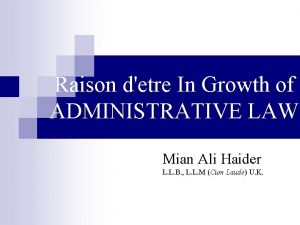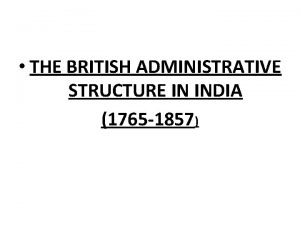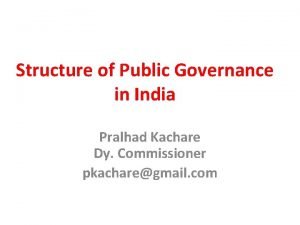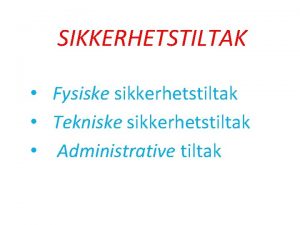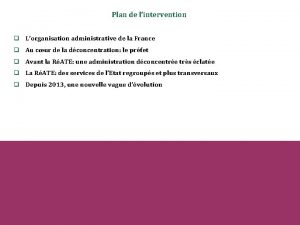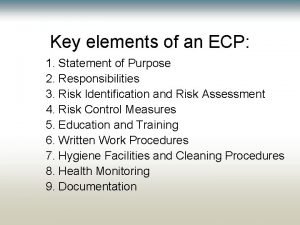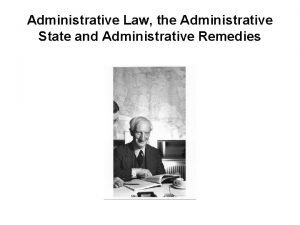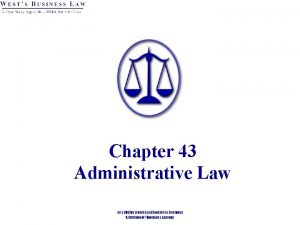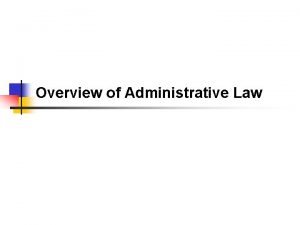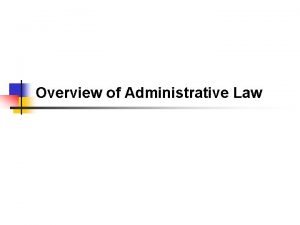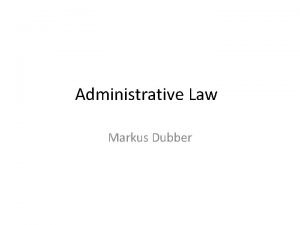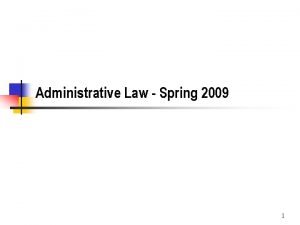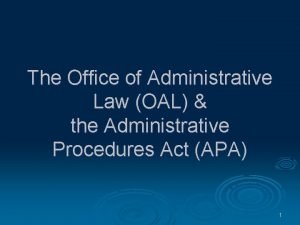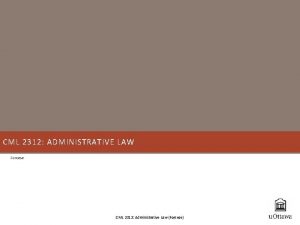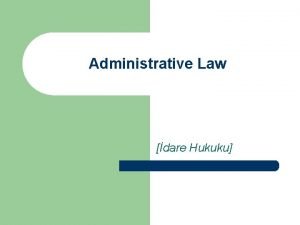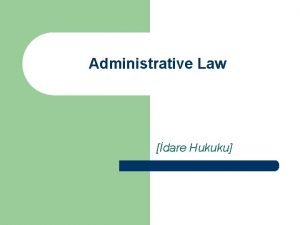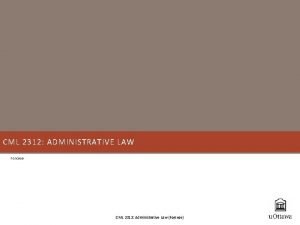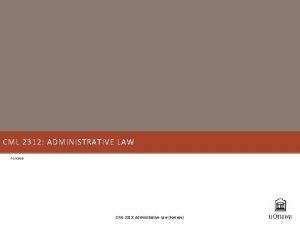Introduction to EU Law EU Administrative Law Dr

















- Slides: 17

Introduction to EU Law: EU Administrative Law Dr. Pollák Kitti Pollak. Kitti@uni-nke. hu

Why the EU? THE AIM OF THE EU IS TO: maintain and build on the peace established between its Member States and its neighbours; bring European countries together in practical cooperation; ensure that European citizens can live in security; promote economic and social solidarity; preserve European identity and diversity in a globalised world; promote the values that Europeans share.

The deepening of European integration – Enlargement of the EU Enlargement means the admission of new member states to EU (the Treaties) Deepening means the intensification of collaboration (qualitative changement in the integration) and the expansion to other fields.

Enlargement of the EU: From 6 to 28 Member States 1957: Belgium, France, Germany, Italy, Luxembourg and the Netherlands 1973: Denmark, Ireland, United Kingdom 1981: Greece 1986: Portugal, Spain 1995: Austria, Finland, Sweden 2004: Cyprus, Czech Republic, Estonia, Hungary, Latvia, Lithuania, Malta, Poland, Slovakia Slovenia 2007: Bulgaria, Romania 2013: Croatia

Who can join? The Treaty on European Union states that any European country may apply for membership if it respects the EU's democratic values and is committed to promoting them. But specifically, a country can only join if it meets all the membership criteria: political – it must have stable institutions guaranteeing democracy, the rule of law and human rights economic – it must have a functioning market economy and be able to cope with competitive pressure and market forces within the EU legal – it must accept established EU law and practice – especially the major goals of political, economic and monetary union. Accession criteria (Copenhagen criteria) The Treaty on European Union sets out the conditions (Article 49) and principles (Article 6(1)) to which any country wishing to become an EU member must conform. Certain criteria must be met for admission. These criteria (known as the Copenhagen criteria) were established by the Copenhagen European Council in 1993 and strengthened by the Madrid European Council in 1995. They are: stability of institutions guaranteeing democracy, the rule of law, human rights and respect for and protection of minorities; a functioning market economy, ability to take on the obligations of membership…

EU institutions But C not ouncil o an E U in f Europe stitu tion is … European Parliament European Council of the European Union European Commission Court of Justice of the European Union (CJEU) European Central Bank (ECB) European Court of Auditors (ECA) European External Action Service (EEAS) European Economic and Social Committee (EESC) European Committee of the Regions (Co. R) European Investment Bank (EIB) European Ombudsman European Data Protection Supervisor (EDPS) Interinstitutional bodies

European Council Established in: 1974 (informal forum), 1992 (formal status), 2009 (official EU institution) Role: Defines the general political direction and priorities of the European Union, The European Council brings together EU leaders to set the EU's political agenda. It represents the highest level of political cooperation between EU countries. DECIDES ON THE EU'S OVERALL DIRECTION AND POLITICAL PRIORITIES – BUT DOES NOT PASS LAWS. DEALS WITH COMPLEX OR SENSITIVE ISSUES THAT CANNOT BE RESOLVED AT LOWER LEVELS OF INTERGOVERNMENTAL COOPERATION One of the EU's 7 official institutions, the Council takes the form of (usually quarterly) summit meetings between EU leaders, chaired by a permanent president. Members: Heads of state or government of EU countries, European Commission President, High Representative for Foreign Affairs & Security Policy President: Donald Tusk Location: Brussels (Belgium)

Council of the European Union Established in: 1958 (as Council of the European Economic Community) Role: Voice of EU member governments, government ministers from each EU country meet to discuss, amend adopt laws, and coordinate policies. The ministers have the authority to commit their governments to the actions agreed on in the meetings. Together with the European Parliament, the Council is the main decision-making body of the EU. Members: Government ministers from each EU country, according to the policy area to be discussed President: Each EU country holds the presidency on a 6 -month rotating basis Location: Brussels (Belgium)

European Commission Established in: 1958 Role: Promotes the general interest of the EU by proposing and enforcing legislation as well as by implementing policies and the EU budget The European Commission is the EU's politically independent executive arm. Members: A team or 'College' of Commissioners, 1 from each EU country President: Jean-Claude Juncker Location: Brussels (Belgium)

European Parliament Established in: 1952 as Common Assembly of the European Coal and Steel Community, 1962 as European Parliament, first direct elections in 1979 Role: Directly-elected EU body (every 5 years. The last elections were in May 2014. ) legislative, supervisory, and budgetary responsibilities Members: 751 MEPs (Members of the European Parliament) (The number of MEPs for each country is roughly proportionate to its population, ) President: Antonio Tajani Location: Strasbourg (France), Brussels (Belgium), Luxembourg

Court of Justice of the European Union (CJEU) Established in: 1952 Role: Ensuring EU law is interpreted and applied the same in every EU country; ensuring countries and EU institutions abide by EU law. Members: Court of Justice: 1 judge from each EU country, plus 11 advocates general Location: Luxembourg

The deepening of European integration: the Treaties Different ideas of EU: Churchill (United States of Europe) De Gaulle (Europe of Nations) The Treaty of Paris establishing the European Coal and Steel Community (ECSC) (18 April 1951; 25 July 1952) The Treaty of Rome establishing the European Economic Community (EEC) (25 March 1957; 1 January 1958) The Treaty of Rome establishing the European Atomic Eenergy Community (Euratom) (25 March 1957; 1 January 1958) The Treaty establishing a Single Council and a Single Commission of the European Communities – Merger Treaty (8 April 1965; 1 July 1967) The Single European Act (18 February 1986; 1 January 1987) The Treaty on European Union – Treaty of Maastricht (7 February 1992; 1. November 1993) The Treaty of Amsterdam (2 October 1997; 1 May 1999) The Treaty of Nice (26 February 2001; 1 February 2003) The Treaty of Lisbon (13 December 2007; 1 December 2009).

The Reform Treaty = Treaty of Lisbon (2007) – 1 December 2009. The Treaty of Lisbon entered into force. Contrary to the Constitutional Treaty, The Reform Treaty doesn’t state explicitly the supremacy of Community law. The Reform Treaty doesn’t include references to the Union’s symbols – the flag, the anthem and the motto – either. The Reform Treaty doesn’t incorporate the Charter of Fundamental Rights into the Treaties, but it does include a reference to the rights enshrined in the Charter. The Union Minister for Foreign Affairs proposed by the Constitutional Treaty will be replaced by the name „High Representative of the Union for Foreign Affairs and Security Policy”. It’s important to emphasize that the Treaty of Lisbon doesn’t replace the Treaty on European Union (EU Treaty) and the Treaty establishing the European Community (EC Treaty); it only amends them and renames the latter the Treaty on the functioning of the European Union. The Treaty of Lisbon in an amending Treaty in classical sense: it amends but doesn’t replace the Treaties in force. INSTITUTIONAL CHANGEMENTS: Parliament’s powers have been gradually extended in law-making (ordinary legislative procedure has been extended to several new fields such as legal immigration, penal judicial cooperation, crime prevention, police cooperation and some aspects of trade policy and agriculture). The Treaty of Lisbon enforces the principle of subsidiarity. Any national parliament may flag a proposal for EU action which it believes doesn’t respect this principle According to the Treaty of Lisbon the European Council becomes a full EU institution.

Division of competences within the European Union The Treaty of Lisbon clarifies the division of competences between the EU and its member countries. Alongside the principles of subsidiarity and proportionality, sits the principle of conferral (Article 5 of the Treaty on European Union - TEU). This principle means that the EU can only act within the limits of the competences that have been conferred upon it by the EU treaties. These competences are defined in Articles 2 -6 of the Treaty on the Functioning of the EU (TFEU). There are 4 types of competences: exclusive (Article 3 TFEU) only the EU can act in these areas e. g. customs union & trade policy; shared between the EU and EU countries (Article 4 TFEU). EU countries can act only if the EU has chosen not to, e. g. cohesion policy, energy & environment. EU countries may ask the Commission to repeal an adopted legislative act in one of the shared areas so as to better ensure compliance with the principles of subsidiarity and proportionality (Declaration No 18 annexed to the Treaty of Lisbon); EU sets up arrangements within which EU countries must coordinate policy (Article 5 TFEU) e. g. economic policy; EU can support, coordinate or supplement EU countries' actions (Article 6 TFEU) e. g. culture & tourism.

EU Administrative Law European Administrative Space (1992) 90’s: Good administration ADMINISTRATIVE LAW PRINCIPLES (OECD Sigma papers 27. 1999. ) Reliability and Predictability Openness and Transparency Accountability Efficiency and Effectiveness The principles enumerated above can be found in administrative law across all European countries. Although public administrations in European States are old structures, they have continuously adapted to modern conditions including EU Membership, which is itself evolving. Constant contact amongst public servants of Member States and the Commission, the requirement to develop and implement the acquis communautaire at equivalent standards of reliability across the Union, the emergence of a Europe-wide system of administrative justice, and shared basic public administration values and principles, have led to some convergence amongst national administrations. This has been described as the European Administrative Space.

EU Administrative Procedural Law? Effects of the EU Re. NEUAL Model Rules on EU Administrative Procedure Re. NEUAL working groups have developed a set of model rules from 2009 until 2014. The Re. NEUAL Model Rules 2014 are designed as a draft proposal for binding legislation identifying - on the basis of comparative research - best practices in different specific policies of the EU, in order to reinforce general principles of EU law. For the 2014 Online version see: Introduction to the Re. NEUAL Model Rules / Book I – General Provisions Book II – Administrative Rule-Making Book III – Single Case Decision-Making Book IV – Contracts Book V – Mutual Assistance Book VI – Administrative Information Management

Thank you for your attention!
 Administrative law
Administrative law Nature of administrative law
Nature of administrative law Adl 2601
Adl 2601 Newton's first law and second law and third law
Newton's first law and second law and third law Newton's first law
Newton's first law Boyle's law charles law avogadro's law
Boyle's law charles law avogadro's law Constant in avogadro's law
Constant in avogadro's law Nih administrative supplement example
Nih administrative supplement example Administrative records
Administrative records Administrative stuff
Administrative stuff The british administrative structure in india(1765-1857)
The british administrative structure in india(1765-1857) Administrative hierarchy in india
Administrative hierarchy in india Sikkerhetstiltak i butikk
Sikkerhetstiltak i butikk Generic administrative functions
Generic administrative functions Organisation administrative de la france
Organisation administrative de la france Report writing
Report writing Les règles générales de la communication écrite
Les règles générales de la communication écrite Ecp-1
Ecp-1

